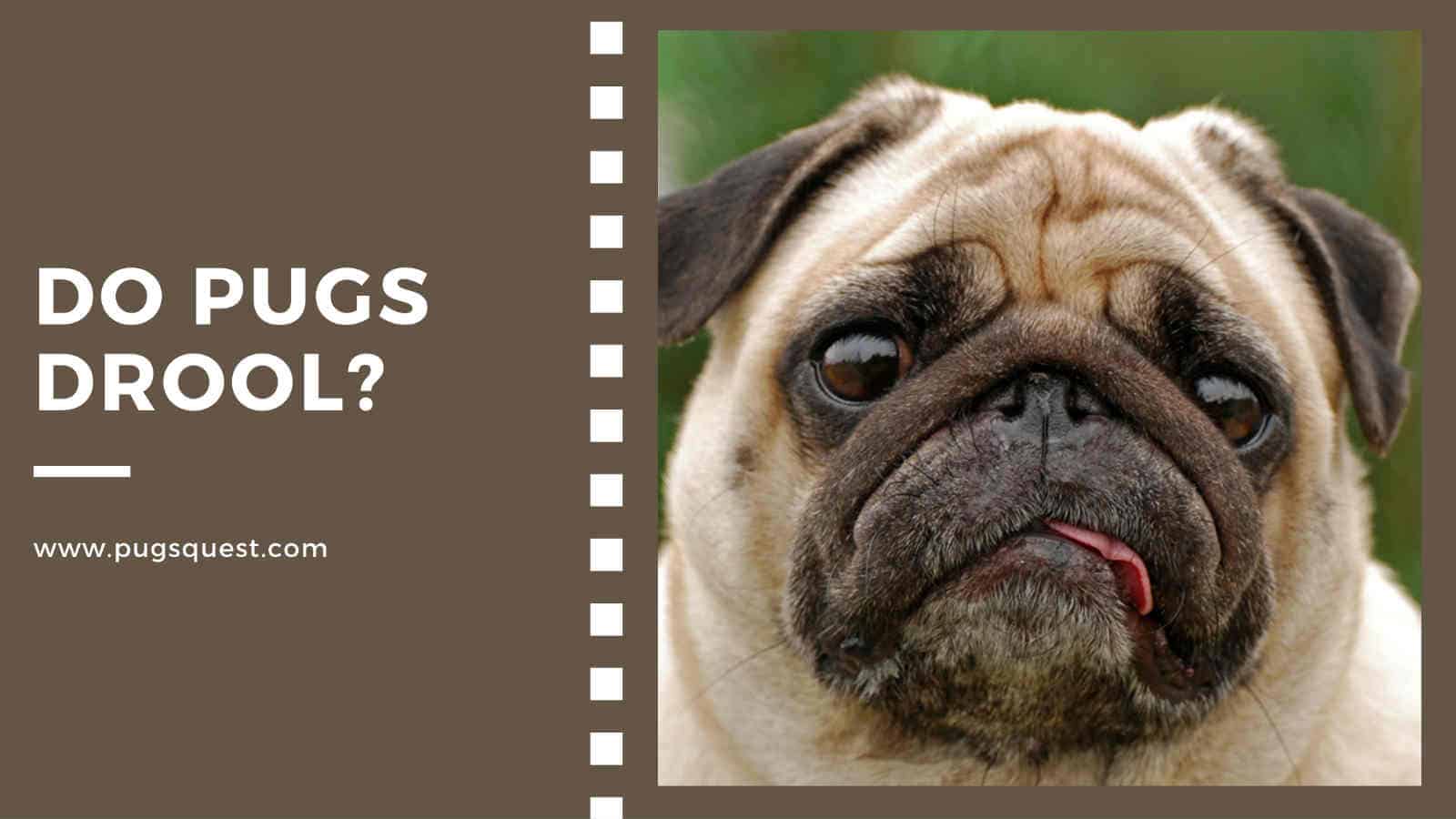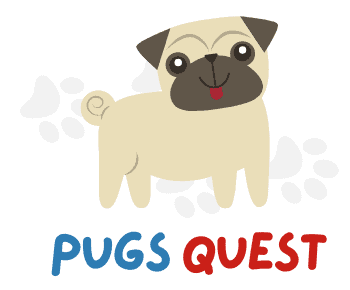
Whatever your current situation, nobody likes an overly-drooly companion.
So do Pugs drool?
What’s normal and what’s not?
I’m going to talk about all things Pug drool and saliva.
Shall we begin?
Do Pugs Drool?
The short answer is yes. All dogs drool to some extent, and Pugs are no exception. The important thing is to know when enough is enough and too much drool is something to be concerned about.
But don’t worry, we’ll be getting to that in just a moment.
Moderate levels of drooling are completely natural for your Pug. In fact, brachycephalic breeds tend towards the slobbier side due to their compressed jaws, large lips, and heavy open-mouthed breathing. Often a result of overheating.
Pug Drooling: Is It Normal or Abnormal
Some moderate Pug drool is completely normal. Your Pug might drool when they smell something tasty, for example. Or when excited, stressed, or in ‘heat’. Saliva production also serves a very important function within the digestive system.
But excessive saliva production is not normal.
Signs of excessive Pug drooling include a saliva-soaked muzzle, spit bubbles, foaming at the mouth, and large streaks of drool that may hang from the mouth or puddle on the floor.
Excessive drooling is an indication of Ptyalism in your dog (a condition that causes an overproduction of Saliva). Ptyalism is usually detected due to increased salivation or an unusual consistency in a Pug’s saliva.
If you notice that your Pug is drooling more than normal, without apparent cause, or that their saliva looks different in some way, we recommend booking an appointment with your vet as soon as possible.
Other symptoms to look out for, include:
- Loss of appetite
- Change in behavior
- An inflamed mouth or lips
- Saliva that is white and foamy
- Sudden vomiting or diarrhea
Top Causes of Excess Pug Drooling
There are many reasons why your Pug might be drooling more than usual. And these reasons range from eminently solvable to slightly more worrying.
Excess drooling is sometimes a sign of illness. If you notice above-average drooling, we recommend visiting your vet to rule out anything potentially life-threatening. Most of the time, however, there will be a simple way to help your Pug drool a bit less.
So, what are some common (and some less common) causes of that dreadful drool?
1. Something tasty
If your Pug smells good food, they are likely to start salivating. This is a completely normal response as the body gets ready for digestion.
Your pup won’t just salivate at their own treats. If you’ve been cooking up a storm all afternoon, your pup might start drooling at the delight of it.
2. Something not so tasty
Likewise, if your Pug eats something a bit ‘yucky’ then they might produce some excess saliva to wash that horrible taste away.
This doesn’t happen very often but if your Pug has been subjected to taking foul-tasting medicine before you may have noticed this phenomenon already.
3. Spice
If your Pug eats something spicy, expect a puddle of drool or too. Pugs will not enjoy this experience and saliva is their body’s natural response to cool things down.
4. Motion sickness
Just like us, your Pug might start to feel queasy in the car. Drooling is a very common sign of motion sickness and may also accompany vomiting and unrest.
If your Pug is prone to motion sickness try not to feed them for an hour or so before setting off. A small, dry snack just before the journey will settle their belly.
Invest in a canine car seat to keep your Pug in a relatively sedentary position and try to take regular breaks to avoid any heavy motion sickness.
5. BOAS
BOAS stands for Brachycephalic Obstructive Airway Syndrome and is a common disorder amongst Pugs due to their compressed skeletal structure.
BOAS means that your Pug is predisposed to experience breathing difficulties. You may notice that they produce excess drool during exercise.
To keep your Pug comfortable and healthy, make sure that you clean between their skin folds and muzzle regularly to prevent the accumulation of bacteria that could lead to infection.
6. Overheating
If you have a Pug of your own, you’re probably well aware of their tendency to overheat. As a brachycephalic breed, Pugs have difficulty regulating temperature – especially during very hot weather.
Pugs can easily suffer from heatstroke if not kept cool. Drooling is one symptom of heatstroke, alongside heavy panting, vomiting, and other associated symptoms.
Top-tip: if you suspect your Pug is suffering from heatstroke, contact your veterinarian immediately.
7. Teething
If you notice your Pug puppy drooling it’s probably the result of teething. Teething usually occurs when your pup is between 2 and 7 months old.
Drooling during this time is perfectly normal and nothing to worry about. Try offering your pup a chew toy to distract them from the discomfort they are feeling.
But if you notice an excessive amount of saliva, contact your veterinarian asap.
8. A bad belly
Just like us, if your pooch eats something that disagrees with them they might end up with a bad belly. Most often a bad belly is the result of a heavy meal, bad food, or a tummy bug.
In more serious instances, excess drool could be a sign of poisoning from dangerous substances. If you suspect that your Pug has ingested a toxic chemical such as bleach or household cleaning products, contact your veterinarian immediately.
9. Rabies
The chances that your Pug has rabies are extremely low but it is a potential risk-factor when it comes to drooling. If a diseased animal bites your Pug, you might notice frothing and drool around the mouth and muzzle.
This could potentially develop into seizures. Rabies is serious and must be treated by a veterinarian.
10. Disease
Worst case scenario, excessive drooling might be a sign of disease. If your Pug is suffering from gum disease, they will produce excess saliva. Likewise, drooling is sometimes a symptom of oral tumors that will require immediate medical attention.
How To Care For A Drooling Pug
If your Pug has a case of drooling, there are many things you can do to help. Once you’ve ruled out any serious health concerns try out some of these top care tips.
- Regularly clean facial wrinkles, armpits, and lip folds. This will prevent the build-up of bacteria leading to yeast and fungal infections.
- Know your Pug’s drooling habits. You’ll know what’s normal for them and be able to act when you notice any significant changes.
- Take your Pugs temperature. If it rises any higher than 39 degrees, call the vet.
- Check your Pugs’ breathing and heart rate. If it’s too high call the vet. This is a sign that your pup is under stress.
- Place an absorbent towel where your Pug rests their head at night to catch excess drool. A puppy training pad is a great hack for this.
- Monitor vital signs and notify your vet of any abnormalities. Wheezing, gasping, and/ or heavy snoring for example.
Ditch The Pug Drool
Whilst saliva production is perfectly normal and healthy for your Pug, excess drooling could be a sign of something more sinister.
By knowing your pet’s ‘normal’ level of saliva production, you’ll be able to identify when something’s not quite right.
Do Pugs drool?
Yes, they do. But it’s important to know when drooling becomes excessive.
